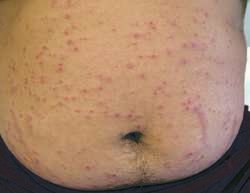Scabies
Definition
Scabies is a relatively contagious infection caused by a tiny mite(Sarcoptes scabiei).
Description
Scabies is caused by a tiny insect about 0.3 mm long called a mite. When a human comes in contact with the female mite, the mite burrows under the skin, laying eggs along the line of its burrow. These eggs hatch, and the resulting offspring rise to the surface of the skin, mate, and repeat the cycle either within the skin of the original host, or within the skin of its next victim.
The intense itching almost always caused by scabies is due to a reaction within the skin to the feces of the mite. The first time someone is infected with scabies, he or she may not notice any itching for a number of weeks (four to six weeks). With subsequent infections, the itchiness will begin within hours of picking up the first mite.
Causes and symptoms
Scabies is most common among people who live in overcrowded conditions, and whose ability to practice good hygiene is limited. Scabies can be passed between people by close skin contact. Although the mites can only live away from human skin for about three days, sharing clothing or bedclothes can pass scabies among family members or close contacts. In May 2002, the Centers for Disease Control (CDC) included scabies in its updated guidelines for the treatment of sexually transmitted diseases.
The itching, or pruritus, from scabies is worse after a hot shower and at night. Burrows are seen as winding, slightly raised gray lines along the skin. The female mite may be seen at one end of the burrow, as a tiny pearl-like bump underneath the skin. Because of the intense itching, burrows may be obscured by scratch marks left by the patient. The most common locations for burrows include the sides of the fingers, between the fingers, the top of the wrists, around the elbows and armpits, around the nipples of the breasts in women, in the genitalia of men, around the waist (beltline), and on the lower part of the buttocks. Babies may have burrows on the soles of their feet, palms of their hands, and faces.
Scratching seems to serve some purpose in scabies, as the mites are apparently often inadvertently removed. Most infestations with scabies are caused by no more than 15 mites altogether.
Infestation with huge numbers of mites (on the order of thousands to millions) occurs when an individual does not scratch, or when an individual has a weakened immune system. These patients include those who live in institutions; are mentally retarded, or physically infirm; have other diseases which affect the amount of sensation they have in their skin (leprosy or syringomyelia); have leukemia or diabetes; are taking medications which lower their immune response (cancerchemotherapy, drugs given after organ transplantation); or have other diseases which lower their immune response (such as acquired immunodeficiency syndrome or AIDS). This form of scabies, with its major infestation, is referred to as crusted scabies or Norwegian scabies. Infected patients have thickened, crusty areas all over their bodies, including over the scalp. Their skin is scaly. Their fingernails may be thickened and horny.
Diagnosis
Diagnosis can be made simply by observing the characteristic burrows of the mites causing scabies. A sterilized needle can be used to explore the pearly bump at the end of a burrow, remove its contents, and place it on a slide to be examined. The mite itself may then be identified under a microscope.
Occasionally, a type of mite carried on dogs (Sarcoptes scabiei var. canis) may infect humans. These mites cannot survive for very long on humans, and so the infection is very light.
Treatment
Several types of lotions (usually containing 5% permethrin) can be applied to the body, and left on for 12-24 hours. One topical application is usually sufficient, although the scabicide may be reapplied after a week if mites remain. Preparations containing lindane are no longer recommended for treating scabies as of 2003 because of the potential for damage to the nervous system. Itching can be lessened by the use of calamine lotion or antihistamine medications.
In addition to topical medications, the doctor may prescribe oral ivermectin. Ivermectin is a drug that was originally developed for veterinary practice as a broad-spectrum antiparasite agent. Studies done in humans, however, have found that ivermectin is as safe and effective as topical medications for treating scabies. A study published in 2003 reported that ivermectin is safe for people in high-risk categories, including those with compromised immune systems.
Prognosis
The prognosis for complete recovery from scabies infestation is excellent. In patients with weak immune systems, the biggest danger is that the areas of skin involved with scabies will become secondarily infected with bacteria.
Prevention
Good hygiene is essential in the prevention of scabies. When a member of a household is diagnosed with scabies, all that person's recently-worn clothing and bedding should be washed in very hot water.
Resources
Books
Beers, Mark H., MD, and Robert Berkow, MD., editors. "Scabies (The Itch)." Section 10, Chapter 114 In The Merck Manual of Diagnosis and Therapy. Whitehouse Station, NJ: Merck Research Laboratories, 2004.
Periodicals
Burroughs, R. F., and D. M. Elston. "What's Eating You? Canine Scabies." Cutis 72 (August 2003): 107-109.

Scabies is a contagious skin infection common among people who live in overcrowded, less than ideal hygienic environments. It is caused by the infestation of female scab mites that, upon contact, burrows under the victim's skin and lays eggs along the lines of passage. Once the eggs hatch, the new mites rise to the skin's surface, mate, and repeats the infestation. Scabies can occur anywhere on the body, including the armpit, groin, buttocks, genital area, and ankles, as shown in the illustration above. (Illustration by Electronic Illustrators Group.)
Burstein, G. R., and K. A. Workowski. "Sexually Transmitted Diseases Treatment Guidelines." Current Opinion in Pediatrics 15 (August 2003): 391-397.
Fawcett, R. S. "Ivermectin Use in Scabies." American Family Physician 68 (September 15, 2003): 1089-1092.
Santoro, A. F., M. A. Rezac, and J. B. Lee. "Current Trend in Ivermectin Usage for Scabies." Journal of Drugs in Dermatology 2 (August 2003): 397-401.
Organizations
American Academy of Dermatology (AAD). 930 East Woodfield Road, Schaumburg, IL 60173. (847) 330-0230. http://www.aad.org.
Key terms
Mite — An insect parasite belonging to the order Acarina. The organism that causes scabies is a mite.
Pruritus — An unpleasant itching sensation. Scabies is characterized by intense pruritus.
Topical — A type of medication applied to the skin or body surface.
Gale Encyclopedia of Medicine. Copyright 2008 The Gale Group, Inc. All rights reserved.
scabies
[ska´bēz, ska´be-ēz] a contagious skin disease caused by the itch mite,
Sarcoptes scabiei. Scabies, sometimes popularly called “seven-year itch,” is most likely to erupt in folds of the skin, such as in the groin, beneath the breasts, or between the toes or fingers. It is classified as a
sexually transmitted disease.
The adult itch mite has a rounded body about one-fiftieth of an inch long. The skin lesions are caused by the female, which burrows beneath the skin and digs a short tunnel parallel to the surface, in which it lays its eggs. The eggs hatch in a few days, after which the baby mites find their way to the skin surface, where they mate and complete the life cycle.
Symptoms. During the initial tunnel digging and egg laying, the human host may be oblivious to what is happening. There is little itching and there are few lesions. In about a month, the itching becomes intense because of hypersensitivity to the mite. The itch is often worse at night. The tunnels in the skin can now be discerned as slightly elevated grayish white lines. The mite itself can often be seen—with the aid of a magnifying glass—as a tiny black speck at the end of the tunnel. Blisters and pustules also may develop in the skin near the tunnel.
Transmission. Scabies is usually transmitted from person to person by direct skin contact. Transmission via clothing and other inanimate objects is uncommon. Epidemics are fairly common in such places as camps, barracks, and institutions. It is unusual for one member of a family not to communicate it to the others. The Centers for Disease Control and Prevention recommend the wearing of gowns and gloves for close contact with an infested person. Masks are not necessary. All contacts that the patient has had should be treated at the same time.
Treatment andPrevention. Scabies treatment consists of topical permethrin cream (Elimite), lindane, or crotamiton (Eurax), applied from the neck down and then washed off. For infants, 5 to 6 per cent precipitated sulfur in petrolatum, applied twice daily for a week, is usually adequate.
Norwegian scabies a rare, severe form of scabies associated with a heavy infestation of Sarcoptes scabiei, seen especially in the senile and mentally retarded, in patients with poor sensation or severe systemic disease, and in immunocompromised patients; it apparently represents an abnormal host immune response to the etiologic agent. Characteristics include a marked crusting dermatitis of the hands and feet with subungual horny debris, erythematous scaling plaques on the neck, scalp, and trunk that may become generalized, and usually lymphadenopathy and eosinophilia.
Miller-Keane Encyclopedia and Dictionary of Medicine, Nursing, and Allied Health, Seventh Edition. © 2003 by Saunders, an imprint of Elsevier, Inc. All rights reserved.

